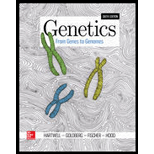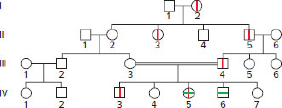
Concept explainers
People with nail-patella syndrome have poorly developed or absent kneecaps and nails. Individuals with alkaptonuria have arthritis as well as urine that darkens when exposed to air. Both nail-patella syndrome and alkaptonuria are rare
| a. | What are the most likely modes of inheritance of nail-patella syndrome and alkaptonuria? What genotypes can you ascribe to each of the individuals in the pedigree for both of these phenotypes? |
| b. | In a mating between IV-2 and IV-5, what is the chance that the child produced would have both nail-patella syndrome and alkaptonuria? Nail-patella syndrome alone? Alkaptonuria alone? Neither defect? |

a.
To determine:
The mode of inheritance of nail-patella syndrome and alkaptonuria, and genotype of each individual that is given in the pedigree.
Introduction:
Nail patella syndrome affects the nail, kidney and skeletal muscles. This kind of syndrome is autosomal dominant because only one copy of the defective gene may cause disease in the person.
Explanation of Solution
Two diseases are discussed in the problem, one is nail-patella (NN), and another is alkaptonuria (aa). It can be observed from the given pedigree that children who are affected with nail-patella have at least one affected parent. Thus, it can be concluded that nail-patella is dominant. When the individuals of a population are crossed in a consanguineous manner, then it results in the appearance of character for alkaptonuria. The characters for alkaptonuria appear in IV- 5 and IV-6 so, it shows the occurrence of these characters in parents also.
The genotype of each individual is as follows:
| Individuals | Genotypes |
| I-1 | nn Aa |
| I-2 | Nn AA |
| II-1 | nn AA |
| II-2 | nn Aa |
| II-3 | Nn AA or Nn Aa |
| II-4 | nn AA or nn Aa |
| II-5 | Nn Aa |
| II-6 | nn AA |
| III-1 | nn AA |
| III-2 | nn AA or nn Aa |
| III-3 | nn Aa |
| III-4 | Nn Aa |
| III-5 | nn AA or nn Aa |
| III-6 | nn AA or nn Aa |
| IV-1 | nn AA or nn Aa |
| IV-2 | nn AA or nn Aa |
| IV-3 | Nn AA or Nn Aa |
| IV-4 | nn AA or nn Aa |
| IV-5 | Nn aa |
| IV-6 | nn aa |
| IV-7 | nn Aa or nn AA |
b.
To determine:
The chance that the produced child by mating IV-2 and IV-5 would have both nail-patella syndrome and alkaptonuria, Nail-patella syndrome alone, alkaptonuria alone and neither defect.
Introduction:
Alkaptonuria is a disease which can be inherited from parents to offsprings, and in this condition, several amino acids are not processed like phenylalanine and tyrosine. In this condition, the colour of the urine turns into black.
Explanation of Solution
The chance that the produced child by mating IV-2 and IV-5 would have both nail-patella syndrome and alkaptonuria.
In this problem, the cross is made between IV-2 and IV-5. The genotype, which is possible for IV-2 is nn AA or nn Aa because the genotype of his father is uncertain. Thus, both the possible genotypes will be considered for solving the problem. If both the syndromes, nail-patella syndrome and alkaptonuria, are inherited to the child than it can be said that the contributed gametes for IV-2 will be ‘n a’ the probability has the individual IV-2 has the genotype nn Aa is 1/4. Genotype nn Aa in IV-2 is possible when the gametes ‘n’ and ‘a’ are inherited from parent III-2. The genotype of III-2 is ‘nn AA’ or ‘nn Aa’ so, the probability of donating each type of gamete is 1/4. The probability of delivering gametes ‘n a’ by IV-2 to its offsprings is 1/2 and the probability of IV-5 providing ‘N a’ gametes is 1/2.
Thus, the probability that the child will have both the diseases can be calculated from above probabilities. Therefore the probability of a child having disease is as follows:
The genotype ‘nn AA’ will not be considered for IV-2 because an individual with this genotype will not donate gametes for alkaptonuria.
The chance that the produced child by mating IV-2 and IV-5 would have the only nail-patella syndrome.
The genotype ‘N- A-’ determines that the child will have the only nail-patella syndrome. This genotype is only possible if the IV-2 has the genotype ‘nn Aa’ and its probability is 1/4. The probability that the gamete ‘A’ will be donated by IV-2 is 1/2 and for IV-5 to deliver gametes ‘N a’ is 1/2.
Thus, if the genotype of IV-2 is ‘nn Aa’ then the probability that the child will have only nail-patella syndrome is as follows:
Similarly, the probability that IV-2 will have genotype nn AA is 3/4. The likelihood that the gametes ‘nA’ will be donated by IV-2 is 1, and the probability that gametes ‘N a’ will be donated by IV-5 is 1/2.
Thus, if the genotype of IV-2 is ‘nn AA’ then the probability that the child will have only nail-patella syndrome is as follows:
The addition of the above probability can determine the actual probability of a child having the only nail-patella syndrome. Thus, the probability is as follows:
The chance that the produced child by mating IV-2 and IV-5 would have only alkaptonuria.
If the children have the genotype ‘nn aa’ then these children will have only alkaptonuria. Children will have genotype ‘nn aa’ if their parents (IV-2) also has genotype ‘nn aa’. The probability that IV-2 has genotype ‘nn aa’ is 1/4. The probability for donating gamete ‘n a’ by IV-2 and IV-5 is 1/2.
Thus, the probability that the child will have the only alkaptonuria is as follows:
Parents with genotype ‘nn AA’ cannot deliver gametes for alkaptonuria. So the parents with genotype ‘nn AA’ will not be considered to obtain the desired probability.
The chance that the produced child by mating IV-2 and IV-5 would be normal.
The probability of a child having neither disease can be calculated by subtracting the summation of the above three probabilities from 1. Thus, the probability of a child having neither syndrome is as follows:
Probability = 1- (probability of having both the syndrome + probability of having only nail-paella + probability of having only alkaptonuria).
Want to see more full solutions like this?
Chapter 2 Solutions
Genetics: From Genes To Genomes (6th International Edition)
- Select all of the following that the ablation (knockout) or ectopoic expression (gain of function) of Hox can contribute to. Another set of wings in the fruit fly, duplication of fingernails, ectopic ears in mice, excess feathers in duck/quail chimeras, and homeosis of segment 2 to jaw in Hox2a mutantsarrow_forwardSelect all of the following that changes in the MC1R gene can lead to: Changes in spots/stripes in lizards, changes in coat coloration in mice, ectopic ear formation in Siberian hamsters, and red hair in humansarrow_forwardPleiotropic genes are genes that (blank) Cause a swapping of organs/structures, are the result of duplicated sets of chromosomes, never produce protein products, and have more than one purpose/functionarrow_forward
- A loss of function mutation in Pitx1 enhancers can cause (blank) Removal of Pitx1 exons and growth of ectopic hindlimbs, growth of extra ectopic forelimbs, loss of forelimb specification and development, and loss of hindlimb specification and developmentarrow_forwardHox1a most likely contributes to (blank) patterning in the developing embryo? Ventral, posterior, limb or anteriorarrow_forwardSelect all of the following that can help establish Hox gene expression boundaries (things that affect Hox and not things that Hox affects). Retinoic acid, anterior/posterior axis, fibroblast growth factors, vagal neural crest, and enhancersarrow_forward
- Ectopic expression of Hox often results in (blank) phenotypes. (Blank) transformations are characterized by the replacement of one body part/structure with another. Hoxeotic, homealoneotic, joexotic, or homeoticarrow_forwardWhat's the difference when drawing omega-6 and omega-3?arrow_forward. Consider a base substitution mutation that occurred in a DNA sequence that resulted in a change in the encoded protein from the amino acid glutamic acid to aspartic acid. Normally the glutamic acid amino acid is located on the outside of the soluble protein but not near an active site. O-H¨ A. What type of mutation occurred? O-H B. What 2 types of chemical bonds are found in the R-groups of each amino acid? The R groups are shaded. CH2 CH2 CH2 H2N-C-COOH H2N-C-COOH 1 H Glutamic acid H Aspartic acid C. What 2 types of bonds could each R-group of each of these amino acids form with other molecules? D. Consider the chemical properties of the two amino acids and the location of the amino acid in the protein. Explain what effect this mutation will have on this protein's function and why.arrow_forward
- engineered constructs that consist of hollow fibers are acting as synthetic capillaries, around which cells have been loaded. The cellular space around a single fiber can be modeled as if it were a Krogh tissue cylinder. Each fiber has an outside “capillary” radius of 100 µm and the “tissue” radius can be taken as 200 µm. The following values apply to the device:R0 = 20 µM/secaO2 = 1.35 µM/mmHgDO2,T = 1.67 x 10-5 cm2/secPO2,m = 4 x 10-3 cm/secInstead of blood inside the fibers, the oxygen transport and tissue consumption are being investigated by usingan aqueous solution saturated with pure oxygen. As a result, there is no mass transfer resistance in the synthetic“capillary”, only that due to the membrane itself. Rather than accounting for pO2 variations along the length ofthe fiber, use an average value in the “capillary” of 130 mmHg.Is the tissue fully oxygenated?arrow_forwardMolecular Biology Please help with question. thank you You are studying the expression of the lac operon. You have isolated mutants as described below. In the presence of glucose, explain/describe what would happen, for each mutant, to the expression of the lac operon when you add lactose AND what would happen when the bacteria has used up all of the lactose (if the mutant is able to use lactose).5. Mutations in the lac operator that strengthen the binding of the lac repressor 200 fold 6. Mutations in the promoter that prevent binding of RNA polymerase 7. Mutations in CRP/CAP protein that prevent binding of cAMP8. Mutations in sigma factor that prevent binding of sigma to core RNA polymerasearrow_forwardMolecular Biology Please help and there is an attached image. Thank you. A bacteria has a gene whose protein/enzyme product is involved with the synthesis of a lipid necessary for the synthesis of the cell membrane. Expression of this gene requires the binding of a protein (called ACT) to a control sequence (called INC) next to the promoter. A. Is the expression/regulation of this gene an example of induction or repression?Please explain:B. Is this expression/regulation an example of positive or negative control?C. When the lipid is supplied in the media, the expression of the enzyme is turned off.Describe one likely mechanism for how this “turn off” is accomplished.arrow_forward
 Human Biology (MindTap Course List)BiologyISBN:9781305112100Author:Cecie Starr, Beverly McMillanPublisher:Cengage Learning
Human Biology (MindTap Course List)BiologyISBN:9781305112100Author:Cecie Starr, Beverly McMillanPublisher:Cengage Learning Human Heredity: Principles and Issues (MindTap Co...BiologyISBN:9781305251052Author:Michael CummingsPublisher:Cengage Learning
Human Heredity: Principles and Issues (MindTap Co...BiologyISBN:9781305251052Author:Michael CummingsPublisher:Cengage Learning
 Concepts of BiologyBiologyISBN:9781938168116Author:Samantha Fowler, Rebecca Roush, James WisePublisher:OpenStax College
Concepts of BiologyBiologyISBN:9781938168116Author:Samantha Fowler, Rebecca Roush, James WisePublisher:OpenStax College Biology (MindTap Course List)BiologyISBN:9781337392938Author:Eldra Solomon, Charles Martin, Diana W. Martin, Linda R. BergPublisher:Cengage Learning
Biology (MindTap Course List)BiologyISBN:9781337392938Author:Eldra Solomon, Charles Martin, Diana W. Martin, Linda R. BergPublisher:Cengage Learning





